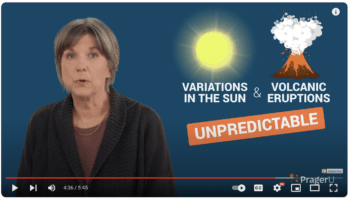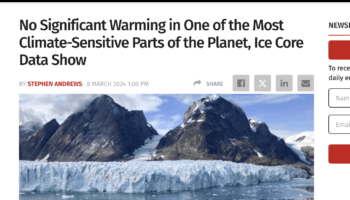- Climate
A lull in solar activity would have little effect on global temperatures; claims of “global cooling” are not based on science
Key takeaway
It is difficult to project solar activity, but research shows that even a substantial lull in solar activity would be far too weak to counteract human-caused global warming.
Reviewed content

Verdict:
Claim:
Forward projections of solar cyclicity imply the next few decades may be marked by global cooling rather than warming, despite continuing CO2 emissions.
Verdict detail
Incorrect: Even if solar activity does decline in the near future , the climate would continue to warm due to elevated greenhouse gas concentrations.
Inadequate support: No reference is provided for the claim that solar activity is projected to decline beyond other Heartland Institute publications.
Full Claim
Forward projections of solar cyclicity imply the next few decades may be marked by global cooling rather than warming, despite continuing CO2 emissions.

Senior Scientist, Potsdam Institute for Climate Impact Research (PIK)
Comment taken from two prior evaluations of similar statements.
While there are some indicators that future solar activity might indeed be lower, this will have little effect on global temperatures. See, for example, this RealClimate post based on Feulner and Rahmstorf (2010)1.
The results have been confirmed by a number of follow-up studies2-4.
While regional and seasonal effects might be larger, the expected global temperature response to a future grand solar minimum similar to the Maunder Minimum is a cooling of about 0.1°C. It should be pointed out that this cooling would occur on the background of current anthropogenic warming which is about a factor of 10 larger[…] It is also clear from these numbers that a future grand solar minimum (which would last only for a few decades anyway) would not save us from global warming, as we have shown in a scientific paper* and explained in this RealClimate post. The marginal temperature differences between warming scenarios with and without a future Maunder Minimum is illustrated here:

Figure – Rise of global temperature for two different emission scenarios (A1B, red, and A2, magenta). The dashed lines show the slightly reduced warming in case a Maunder-like solar minimum should occur during the 21st century. The blue line represents global temperature data. Source: PIK.
- 1- Feulner and Rahmstorf (2010) On the effect of a new grand minimum of solar activity on the future climate on Earth, Geophysical Research Letters
- 2- Anet et al (2013) Impact of a potential 21st century “grand solar minimum” on surface temperatures and stratospheric ozone. Geophysical Research Letters [“although the solar minimum results in a reduced global warming, it cannot compensate continuing anthropogenic impacts.“]
- 3- Meehl (2013) Could a future “Grand Solar Minimum” like the Maunder Minimum stop global warming? Geophysical Research Letters [“a future grand solar minimum could slow down but not stop global warming.“]
- 4- Jones et al (2012) What influence will future solar activity changes over the 21st century have on projected global near-surface temperature changes? Journal of Geophysical Research Atmospheres. [“the possible mitigation potential for future solar activity changes is much smaller than the known uncertainties and ranges in the future anthropogenic response.“]

Professor, Lamont-Doherty Earth Observatory, Columbia University, and Director, Center for Climate and Life
Forward projections of solar variability are fraught with deep uncertainties, as exemplified by the last solar minimum. Satellite observations show this to be the weakest solar cycle in over a century.
The one thing we are nearly certain of is that the years ahead will see increasing carbon dioxide concentrations in the atmosphere due to increasing emissions if nothing is done to reverse course. We know carbon dioxide and methane are greenhouse gases that trap heat in the atmosphere.

Postdoctoral researcher, Los Alamos National Laboratory
The claim that the Earth may cool in coming decades due to solar variability is incorrect (even in the word “may”). It has no bearing in any climate science, model projections, or basic physical theory. The forcing from solar variability to the heat content of the Earth system is small relative to the accelerating forcing provided by human CO2 emissions.



